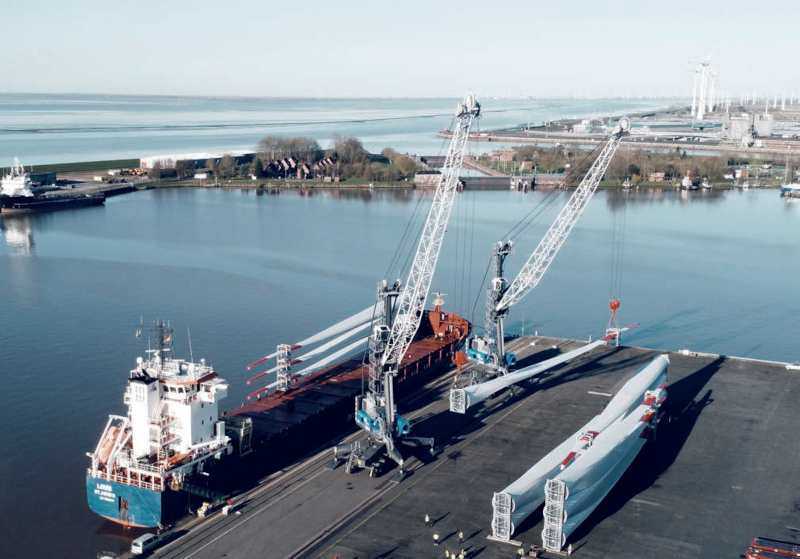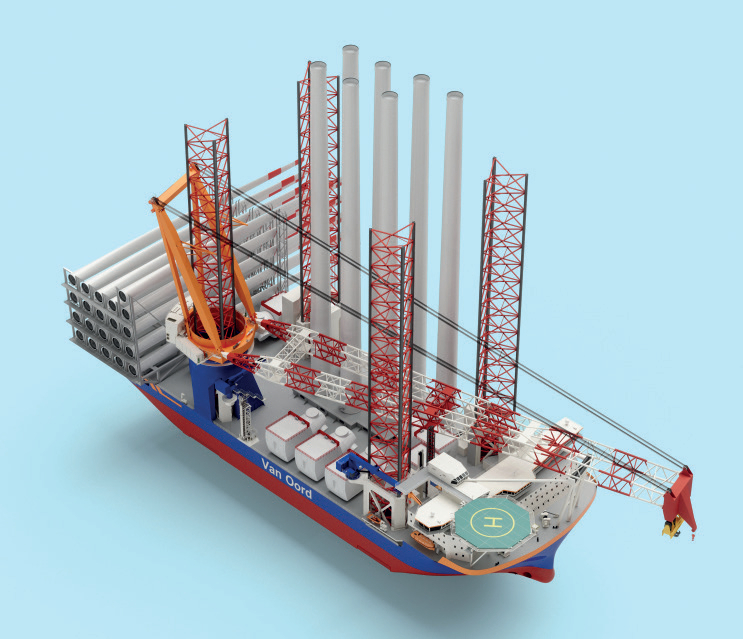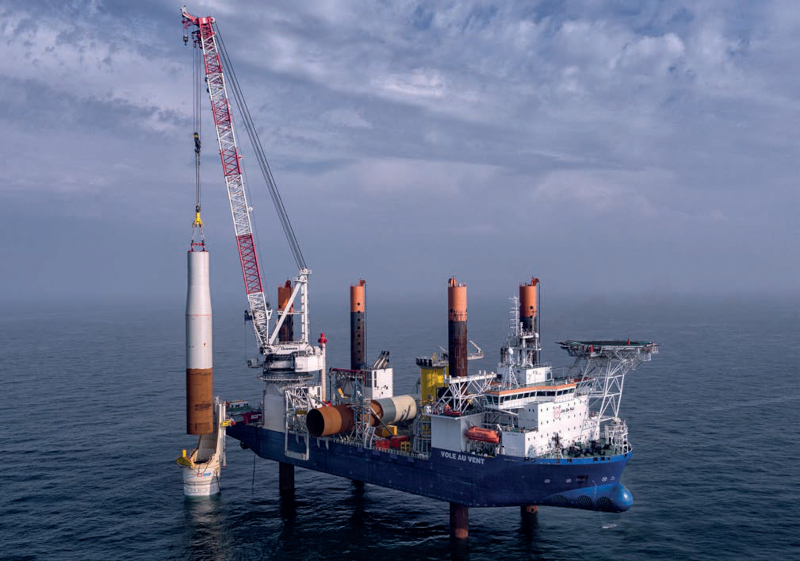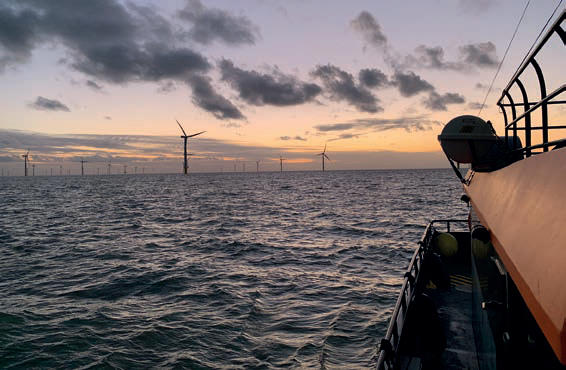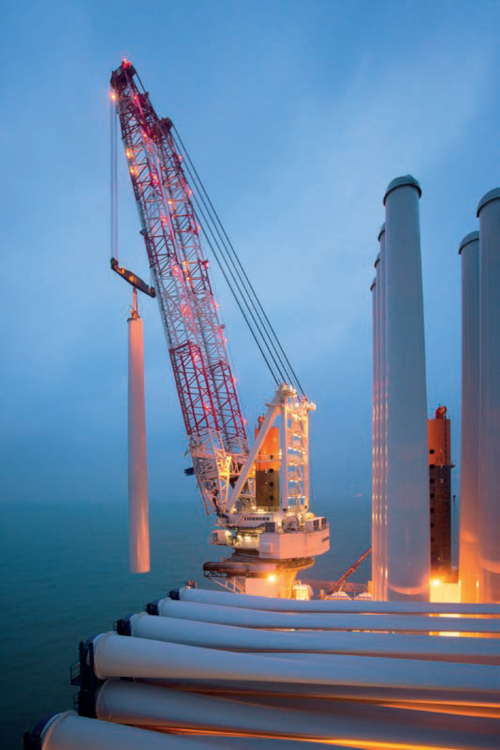Blowing in the wind
21 January 2022Wind power is one of the most important renewable energy sources available to us. Wind farms, offshore wind farms in particular, are growing; but their size and location set special lifting challenges. Julian Champkin reports.
As a growth sector it is little short of astonishing. Offshore wind has grown from almost nothing a decade ago to a current installed capacity of 35 GW worldwide, and progress is only accelerating. Britain has currently more capacity installed than any other country; the largest wind farm in the world, and the first ever to exceed 1GW of power, is the 1.2 GW Hornsea Project One, off Yorkshire; in 2022 it will be overtaken by its sister project Hornsea Two which will power well over 1.3 million homes. By 2030 the UK will be getting about a third of its electricity from offshore wind.
The Netherlands installed nearly 1.5 GW of offshore wind in 2020, followed by Belgium with 706 MW. Germany and China are other major players; China led the world in new installations with more than 3 GW of offshore wind grid connected in 2020 - but markets are opening up worldwide. In October Taiwan’s chamber of commerce organised a 1000-participant (virtual and physical) event with the aim of expanding its present two wind farms to become the second-largest offshore wind market in Asia (after mainland China), a programme that includes upscaling port infrastructure and generating renewable hydrogen from offshore wind. Such a project - the first in the world - is already underway in the North Sea with a pilot offshore hydrogen plant ten kilometres off the coast of Holland.
In September the Global Wind Energy Council forecast that 235 GW of new offshore wind capacity will be installed over the next decade under current policies. Wind, it finds, has the biggest growth potential of any renewable energy technology.
Perhaps the defining characteristic of offshore wind farms, as opposed to onshore, is size. Winds at sea are greater; higher towers are much more efficient at capturing them.
The first offshore turbine in UK waters was Vindeby in 1991; it was 54m tall and generated 0.4Mw. General Electric’s Haliade X design is 260m tall with a 220m diameter rotor, and generates, from a single tower, 12MW. In offshore wind, size matters.
Lifting ever-larger components therefore is a vital part of wind farm installation, not only for the monopiles and turbine blades but also for the offshore transformer platforms that send the generated energy to shore. Early efforts were adapted from offshore oil expertise but specialist dedicated cranes and lifting vessels are now the order of the day. They are found both in ports that load components, on vessels that transport them, and on jacking vessels and rigs that erect them on site.
Among recent developments, KenzFigee has signed a contract with Iv-Offshore & Energy to deliver an electric hydraulic ram luffing offshore crane for installation on the state-of-the-art offshore converter platform for the 100-turbine Sofia Offshore Wind Farm, which is to be sited on the Dogger Bank some 195 km off the northeast of England, making it one of the farthest from shore. The heavy-duty crane is especially suited for harsh North Sea conditions. A compact and robust design is coupled with a limited number of moving parts for low maintenance – essential for an offshore crane. It has a 40-metre box boom which enables personnel handling and supply boat lifts, and platform lifts with safe working loads from 19 to 25 tonnes.
In November 2021 maritime service company Boskalis was awarded the contract for transportation and installation of the monopile foundations and substations for a farm with a value of approximately EUR 450 million. It will use its state-of-the-art Bokalift 1 and Bokalift 2 crane vessels and its heavy transport fleet; the contract ties up one year of crane vessel utilisation days in addition to the equivalent of two years of heavy transport vessels.
The USA is behind Europe and China in terms of offshore wind, but that is changing. The Biden administration aims to have 30 gigawatts of offshore wind operating by 2030. Today the US has a fraction of that – just 42 MW from seven east-coast turbines. A legal constraint to installation has been the Jones Act, which requires shipping between US ports to operate only vessels built and owned by US citizens or permanent residents. It applies to installation vessels also. Dominion Energy, a Virginia, USA-based power and energy company, has therefore commissioned Dutch offshore lifting specialist Huisman to fabricate a crane that will be used on what it says will be the first Jones Act-compliant offshore wind installation vessel in the USA.
Liebherr, from their dedicated dock at Rostock in Germany, has been a major player in loading wind-farm components, in transporting them, and in erection at sea. “We like to say that once a component reaches us at Rostock, it is Liebherr all the way,” says marketing manager Stefan Fröbe.
At Rostock they have their rail-mounted TCC 78000, which towers over the area. “It is huge – you can see it from the autobahn from miles away,” says Fröbe. It has a capacity of 1,600t. A common task for it is lifting monopiles arriving by rail, carrying them to the dockside, and lowering them – not onto vessels but directly into the sea.
These huge – 800 tonne, 85 metres long – towers are not put on ships but are floated from dockside to their offshore destination, pulled by tugs.
Blades are high-tech and delicate, and very finely balanced, so need more careful handling; special vessels, often with onboard cranes, are used. Yet a third component of wind farms are the platform rigs designed to hold transformers, servicing machinery and the like. They have, of course, cranes on board. A major cost, and risk factor, of any offshore work is people: transferring them to and from platforms is costly and dangerous. Yet wind farms, and their cranes, will need maintenance. The fewer personnel required to this, the more economical, and the safer.
For which reason Liebherr have introduced their LiMain system. It stands for Liebherr Intelligent Maintenance. The crane maintains itself, with greasing, condition monitoring and the like all remotely handled from onshore. With no need for a human crane operative, safety and economy are greatly increased.
“A common factor in all offshore operations is space,” says Fröbe. “It is at an absolute premium at sea and on the support vessels and platforms.” For that reason the CAR has been devised.
CAR stands for Crane Around Leg. Jack-up installation vessels stabilise themselves, and raise themselves above the water, by extending four or more legs down to the seabed. The legs extend also above the deck; the slewing ring of the crane fits around the leg, and using the legs as a central column down the middle of the on-board crane is a sensible space-saving design that leaves the vessel deck completely free. Liebherr’s CAL 6400 has a capacity of 1,700t and jib length of 108m and can be used, for example, to lift three-blade turbine assemblies up for installation on the nacelle.
Dutch offshore specialists Huisman also have cranes on the same principle – they call theirs LECs, for Leg Encircling Cranes. In November 2021 they received an order, from offshore installation specialists Van Oord, for their largest LEC yet, in terms of capacity, boom length and power. To be fitted to the company’s new installation jack-up vessel to be called Boreas, it will be able to lift over 3,000 tonnes to install 20 MW turbines and their foundations. Components to build as many as seven turbines will be carried on board the vessel. A similar but smaller Huisman crane is already in operation on Van Oorde’s sister vessel the Aeolus.
So many and so varied are the challenges involved in offshore wind farm lifting that Mammoet have launched a competition to find the most imaginative and innovative ways of doing so. This is the fifth of Mammoet’s competitions, organised together with Offshore Wind Innovators and TKI Wind op Zee. It is focussing on safe and efficient transfer of objects from a floating vessel to offshore wind structures avoiding, if possible, using large installation vessels. Positioning of the supply vessel, and transferring the load first to the structure and then to the nacelle are relevant.
The deadline for preliminary expressions of interest is 27th January. For more information, and to enter, please visit
www.offshorewindinnovators.nl/ products/5th-innovation-challenge.
Cranes Today would of course be delighted should one of our readers become a finalist.
